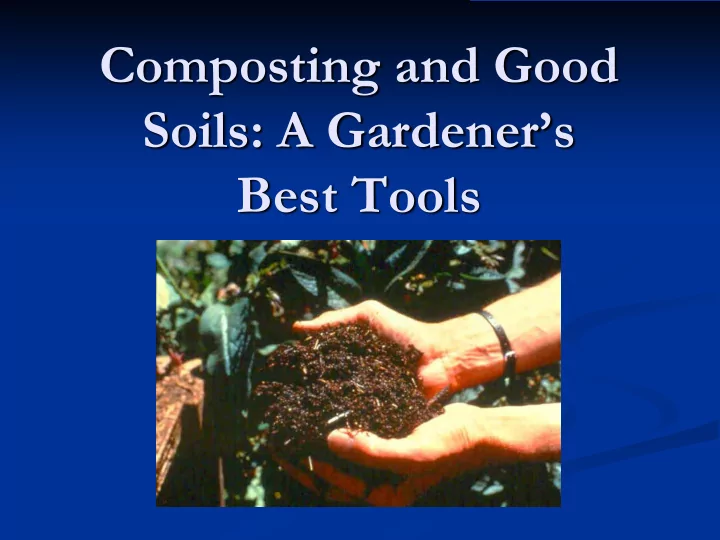

Composting and Good Soils: A Gardener’s Best Tools
Why should we care about healthy soils? Sustain us and make possible our food, shelter, fiber and so much more Promote development of beneficial microbial communities (bacteria/fungi) that allow plants easy access to moisture and nutrients Play an important role in mitigating climate change, through carbon storage and reduction of greenhouse gases
The Importance of Cycles
Back to the Basics: Elements ( Atoms → Molecules → Everything! )
Chemistry is all around (and in) us!
Some of the compounds in a leaf
Plants feed themselves and nd the soil
The Soil Food Web
How Can Soils Help Fight Climate Change? First, a few definitions: "Global warming" refers to the long-term increase in Earth's average surface temperature. "Climate change" refers to any long-term change in Earth's climate , or in the climate of a region or city. This includes warming, cooling and changes besides temperature. The “ Greenhouse Effect” refers to the natural process that traps heat from solar radiation via a layer of atmospheric gases (such as CO 2 , CH 4 and N 2 O) that surround the Earth.
The Carbon Cycle: Our role
Atmospheric CO 2 Concentrations
Human-Caused CO 2 Emissions vs. Atmospheric CO 2 Concentrations
How can soils sequester Carbon? Soil Minerals (a little): CO 2 + CaO = CaCO 3 CO 2 + MgO = MgCO 3 Plants (a lot): make and store C; send extra C to soil to feed microbes
Soils 101 Soil Formation Factors: ClORPT: Climate, Organisms, Relief, Parent Material and Time Soil Texture: Sand/Silt/Clay Soil Structure: Aggregates protect organic matter. Organic matter builds aggregates. Soil Biology and Chemistry: Good soil management fosters active and diverse soil biology and chemistry, which increases resilience and moisture/nutrient availability.
Elements of Sustainable Soil Health Management Low/no till: minimal disruption Organic matter additions (compost, mulch, manures ) Roots in the Ground Cover cropping and continuous cover, with a diverse variety of plants
Best Cover Crops for Northeast Vegetable Gardens* Spring: Clovers, Buckwheat, Hairy Vetch Late Summer: Oats/Peas mixture, Buckwheat *Not ote: Rye ye, t though reco ecommen ended ed, ca can b be e ver ery y invasive a and h hard to control, , as w well a as alle llelo lopathic *www.gardening.cornell/edu/factsheets/ecogardening/impsoil.html
Why Continuous Cover? Bare soils a are u unproductive and u unsustainable! Cover crops: Minimize soil erosion/water runoff Minimize nutrient loss Keep carbon in the soil Reduce compaction/increase aeration Suppress weeds Attract beneficial insects/pollinators “Fix” atmospheric N (legumes) Foster mycorrhizal fungi Add soil organic matter
Legumes “fix” N
Arbuscular Mycorrhizal Fungi A symbiosis between fungus and root (+80% of all plants have it). Nutrient/H 2 0 superhighway AMF hyphae produces glomalin, a glycoprotein that h elps create stable soil aggregates (structure)
Adding Organic Matter: Benefits of Backyard Composting Waste Reduction Greenhouse Gas Reduction (CO 2 , CH 4 ) Organic Matter “Creation”
Waste Reduction U.S. Household Trash Generation: 3/4 ton per person per year (4.3 lbs./day) 25% is food/yard waste (45 m tons) 40% of all food produced is discarded
Greenhouse Gas (GHG) Reduction Composting reduces methane (CH 4 ) from landfills by facilitating aerobic decomposition. Removing organic waste from incinerators makes the process less polluting. Utilizing compost keeps carbon in the soil, reducing formation of CO 2 and feeding soil microorganisms
Five Essentials of Composting Carbon:Nitrogen (C:N) Ratio Volume Moisture Aeration Surface Area
Carbon:Nitrogen (C:N) Ratio Materials High in Carbon: (2 parts) “Browns”: Dry, brown materials such as leaves, straw, paper, woodchips, sawdust Materials High in Nitrogen: (1 part) “Greens”: Moist, fresh materials such as vegetative food scraps and garden waste Always cover greens wit ith browns !
Some C:N Ratios
Composting High Carbon Materials Only (compensate for low N by adding moisture)
2. Volume
3. Moisture
4. Aeration
5. Surface Area
What can you Compost? Yes! No!
Composting Methods: Hot (batching) vs. Cool
Composting Systems
Composting Systems (cont’d)
Regardless of system, leave room to turn the pile.
Composting Tools: Compost Fork* Spade* Thermometer Turning tool Accelerators *only essential tools
Composting Kitchen Scraps Separately
Soil Incorporation
Worm Composting (Vermicomposting)
Using Finished Compost (A soil amendment, not a fertilizer)
Using Finished Compost: Plant Nutrient Overview
Benefits of Using Finished Compost Improves soil health, “tilth”, structure, making life better for plants and soil organisms Conserves moisture (enabling nutrient uptake) and moderates soil temperature, reducing plant stress Organic matter fuels microbial activity, making minerals available to plants and reducing the need for chemical inputs and reducing NPS pollution Suppresses pathogens, reducing plant diseases Neutralizes soil pH, which increases nutrient availability Increases Cation Exchange Capacity (CEC) Etc., etc., etc.
Using Finished Compost: pH and Nutrient Availability
Using Finished Compost Top or Side Dress Potting Mix Soil Incorporation (herbaceous plants only) Seed Starting Mix (mature compost) Compost Tea
Invest in a Soil Test
Virginia Lamb Groundwork Education and Consulting vlamb@groundworkec.com 347-262-0704
Recommend
More recommend